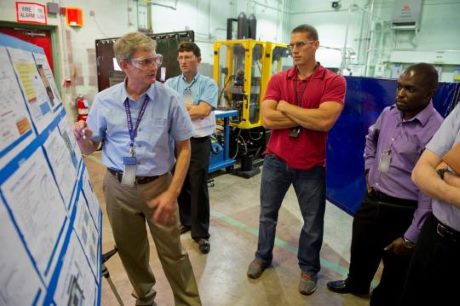Nasa's Glenn Center has called on the services of the US National Nuclear Security Administration (NNSA) to support its mission to develop the Kilopower project, using uranium-fuelled Stirling engines in space missions.
 |
| Y-12 Development, Nasa and DoE officials discuss the work to be done (Image: NNSA) |
Researchers at NNSA's Production Office at Y-12 complex in Tennessee have been tasked with researching materials and manufacturing processes for a physics demonstration of Kilopower's kilowatt-range nuclear reactor.
Y-12 has already provided technical R&D to support the reactor design process and materials compatibility studies, and is now to supply depleted and enriched uranium reactor core prototypes for testing. The prototype cores are to be delivered to the National Criticality Experiments Research Center by the end of fiscal 2016. Critical experiments using the core are due to be carried out in fiscal 2017 under the US Department of Energy's Criticality Safety Program working with Nasa.
The work follows on from successful proof-of-concept testing carried out at NNSA's Nevada National Security site in 2012 in collaboration with Nasa Glenn and National Security Technologies. "Science missions are seeking greater power and functionality," explained Lee Mason, chief of the Thermal Energy Conversion Branch at Glenn. "We're planning to demonstrate the technology in a ground test using a prototype U-235 reactor core.
Space missions require reliable, long-lasting power sources both for propulsion once they are in space and to power experiments and equipment. Radioisotope thermoelectric generators (RTGs) have been widely used as power sources in satellites and other space vehicles such as the Mars rover Curiosity. However, virtually all RTGs are usually powered by plutonium-238, which is now in short supply.
The importance of such power sources was recently illustrated by the European Space Agency's Rosetta mission, which successfully landed the Philae probe on comet 67P/Churymov–Gerasimenko. Equipped with batteries and solar panels, the position in which Philae came to rest on the comet's surface - shielded from the sun's rays by cliffs - meant that the lander was unable to make use of solar energy and was only able to send 64 hours' worth of data before its battery power ran out.
Kilopower would use a heat pipe reactor - a simple, self-regulating reactor producing only the necessary level of thermal power while keeping the core as small and light as possible, a key consideration for a space mission. The thermal energy is transferred through heat pipes to power Stirling engines which exploit the work done when a cylinder of pressurised gas expands on heating to generate electricity on a small scale.
The key to keeping the reactor core as light and efficient as possible is maximising the number of atoms of uranium-235 it contains, so from the point of view of uranium-235 density highly enriched uranium metal would be the best fuel for such a reactor. However, pure metal fuel would present its own problems from a mechanical point of view: for example, the metal becomes very soft at high temperatures.
Work at the Los Alamos National Laboratory completed earlier this year investigated options for fuel including pure metal, uranium doped with small quantities of iron or silicon, uranium alloys and canned fuel. The researchers found that the optimum fuel for the reactor would be an alloy containing 7% molybdenum.
Researched and written
by World Nuclear News





_18570.jpg)
_16159.jpg)
_49205.jpg)





